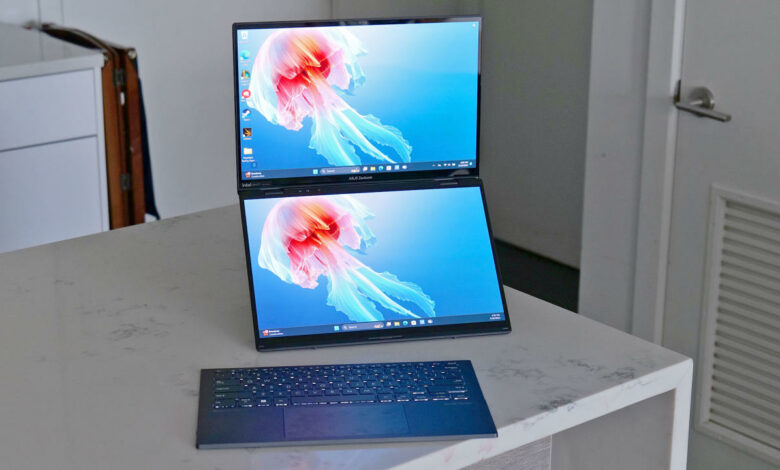The first dual-screen laptop worth buying

Almost every major PC maker has dabbled with the idea of a dual-screen laptop at some point. Way back in 2011, sporting not one but two 14-inch displays. Then at CES 2017, Razer showed off which bumped the panel count to three before demoing something a bit less extravagant a year later in . Fast forward to 2020, when Dell dazzled us with the . Even Apple gave the category a go on the old , only to reverse course and .
Meanwhile, Lenovo has an entire family of devices dating back to the original and culminating most recently in the , with the latter coming extremely close to turning the promise of dual-screen laptops into an actual appealing choice. But now after several generations of its own devices, ASUS has put everything together with the It’s a super sleek machine with two screens that’s barely larger than a similarly sized clamshell. There’s also a detachable keyboard and a built-in kickstand for maximum adaptability. And starting at $1,500, the Zenbook Duo doesn’t command a massive premium for something with a ton of extra utility. So while it’s been quite a journey to get here, ASUS has finally made a dual-screen laptop that proves once and for all that two screens really are better than one.
Starting at $1,500 and with dimensions that aren’t much bigger than a traditional clamshell, ASUS’ Zenbook Duo is the first dual-screen laptop you’d actually want to buy.
- Sleek design
- Gorgeous screens
- Built-in kickstand
- Good port selection
- Solid battery life
- Slightly pricier than a traditional clamshell
- Windows 11 still isn’t optimized for dual-screen laptops
Design
One of the most impressive things about the Zenbook Duo is that it doesn’t look like some kind of Frankendeivce. It’s just a regular-looking 14-inch laptop. Even after you open it, things still look normal with a physical keyboard and touchpad, not to mention a healthy selection of ports around the outside (two Thunderbolt 4, one USB 3.2 Type-A and a full-size HDMI 2.1 jack). A small part of me wishes ASUS had found room for some kind of SD card reader, but I understand if there just wasn’t space.
It’s only after you remove the keyboard that things get interesting because as soon as you do, the Duo’s second display springs to life. From here, you have a ton of options. Tapping three fingers on the lower panel summons a floating touchpad. Alternatively, eight fingers makes a virtual keyboard appear, which you can follow with a swipe up to reveal a traditional keyboard/trackpad combo. But the cool thing is that because these are all virtual stand-ins, it’s easy to swap in a new layout (like for other languages), move the touchpad off to the side or call up a numpad if you need to do some data entry. There’s just so much more flexibility when half of a laptop’s interior isn’t taken up by a rigid set of physical keys.
But things keep getting better, because on the bottom of the Duo is a flap that folds out into a kickstand. This allows you to prop the system up and use both screens as proper displays, sort of like a portable dual-monitor setup but all in a single self-contained system. And because the detachable keyboard connects wirelessly over Bluetooth, you can place it in front (or wherever you want) just like a desktop. The one small drawback to this design is that if you rotate the Duo’s displays into portrait orientation side by side, the design of the kickstand means there’s no way to adjust how far it tilts. This heavily favors the stacked setup with one display above, which is fine because I think that arrangement is more useful in most situations.
Another pleasant surprise is that for a device with two screens, the Zenbook Duo isn’t much bigger or heavier than a typical clamshell. It weighs 3.6 pounds and measures 0.78 inches thick versus the 2.82 pounds and 0.59 inches for a standard Zenbook 14 OLED. And when compared to something like a Dell XPS 14 (3.7 pounds and 0.71 inches thick), both systems are practically the same size.
My one gripe is that ASUS’ dark gray paint job color doesn’t help the Duo stand out. It’s almost like someone who wears subdued colors to avoid drawing attention. But this design is fantastic and I wish ASUS would give this laptop (and the engineers who designed it) the flowers it deserves.
Displays and software
The centerpiece of the Duo is its pair of 14-inch displays, which are an absolute delight. Not only do the matching OLED panels offer strong brightness (around 500 nits), they also pump out rich and accurate colors (100 percent of DCI-P3). But the real magic is when you use both panels together.
Moving apps from one display to another is as simple as dragging and dropping or using the handy menus that appear at the top of the display. In addition, there’s a floating button in the bottom left for ASUS’ ScreenXpert software, which provides shortcuts for adjusting brightness (separately or as a pair), disabling specific panels or pulling up handy widgets for things like a control panel, a handwriting recognition tool, news and weather and more. If the goal was to get as much value out of the Duo’s two displays, I think ASUS’ software does a pretty good job.
The downside to all this is that despite ASUS’ best efforts, Windows 11 and many apps still aren’t fully optimized for systems like this. For example, when I played a round of Teamfight Tactics and wanted to pull up some game stats on the lower display, I ran into an issue where the virtual touchpad stopped working. It was only after I set the game to borderless window mode, closed the game and relaunched everything that it started working again. Granted, situations like this were rare, but it’s important to remember that when you’re using a cutting-edge device, there may be some bugs or awkward interactions.
Performance
The Zenbook Duo comes with an Intel Core Ultra 7 155H processor, 16GB of RAM and a 1TB NVMe SSD. While you can upgrade it with double the memory and a faster Ultra 9 chip, I found the base configuration to be plenty fast. On tests like Geekbench 6 and PCMark 10, the Zenbook Duo turned in results that were identical to those from similarly equipped clamshells, including . This is great because it means there’s not a ton of overhead due to the addition of a second screen and even when setup in desktop mode, dragging apps from one display to another felt snappy and responsive. The obvious drawback is that unlike some 14-inch systems such as the XPS 14, there’s no room for a discrete GPU, which makes the Zenbook Duo better suited to general productivity than more demanding tasks like video editing.
Battery life
You might think a system with two screens would be a battery hog, but the Zenbook Duo fared better than expected. With just one screen on, it lasted 13 hours and 12 minutes on our video rundown test, which is pretty much equivalent to (actually a touch longer than) the Zenbook 14 OLED (12:43). And with both screens going, the Duo’s time only dropped to 10:17, which is still more than enough to survive an entire workday.
Wrap-up
OK, so the Zenbook Duo delivers on the promises of dual-screen laptops. But one question I get a lot is who are devices like this actually for? The most obvious application is for people who carry a portable monitor around while traveling. But more generally, this thing is aimed at anyone who appreciates multiple monitors and wants a system that can recreate that experience in a more travel-friendly way, which is something the Zenbook Duo does with aplomb. The best part though is that it doesn’t make major sacrifices to do so, because thanks to its detachable keyboard, it can function just like any other clamshell when space is tight (like on an airplane).
When you have room to spread out, it transforms into a portable workstation with plenty of screen space for a project up top and bonus real estate for Slack, email, video calls or anything else you might need down below. It’s got ample ports so you don’t need to carry a dongle around and thanks to its gorgeous OLED screens, your work (or play) always looks great. The Zenbook Duo can do everything a traditional laptop can and more. Yes, the software experience could be a bit more polished, though that’s not entirely on ASUS. We still need a new version of Windows to provide better OS support for dual-screen machines. But considering all the struggles and multiple generations it took to get here, the Zenbook Duo is a marvelous torchbearer for a new class of portable PCs.
Source link




